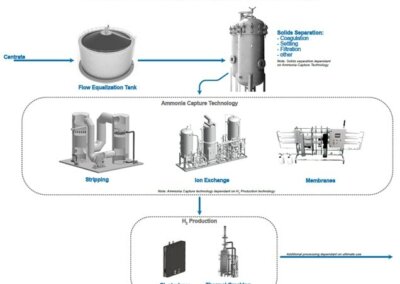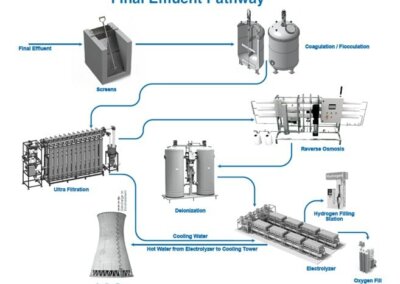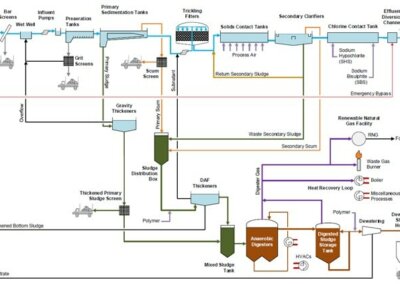About the Project
Driven by increasingly volatile energy markets and climate-related pressures, it is crucial for governments to find alternative sources of energy that are renewable and locally sourced. Hydrogen (H2) plays a key role in achieving the net-zero emissions goal as it is an essential component of decarbonizing energy systems, enabling the transition to a low-carbon economy. However, feasibility of H2 as a viable pathway to decarbonization faces a significant roadblock: the cost of production must be significantly lowered to see increased adoption.
Wastewater treatment plants (WWTP) can be utilized to produce H2 due to available existing infrastructure, waste streams and access to low carbon electricity. By integrating technologies like water electrolysis or ammonia cracking, these plants can contribute to a sustainable and interconnected system as well as reducing GHG emissions.
The Lulu Island (LI) WWTP serves over 170,000 residents of Richmond, BC and is uniquely suited to conducting a feasibility study on H2 production due to the existing biogas clean-up facility and Pilot Digestion Optimization Facility. H2 produced here can be utilized as fuel for vehicles, blended with the natural gas network or even used on-site for energy intensive processes.
GHD was engaged by Metro Vancouver to study the feasibility of H2 production at the LIWWTP. Two production streams were considered: 1. the Final Effluent Pathway, in which wastewater is treated and converted to H2 through electrolysis of water, and 2. the Ammonia Pathway, where the ammonia is stripped from digester centrate and cracked into elemental H2 and nitrogen.
GHD studied and compared the two pathways and after a logically defined study process presented Metro Vancouver with a recommendation for a feasible and viable means to produce very low carbon H2 at the LIWWTP and an innovative pathway forward for improving wastewater circularity for energy, and for increasing the potential for broader H2 adoption in BC.
Approach
- Data gathering & baseline development: GHD formed a baseline understanding of the LIWWTP operations & water quality data to develop key design criteria, overall sizing/capacity limitations & select equipment for each production stream.
- H2 production technology evaluation: GHD worked with vendors to understand each production stream’s technology capability, availability, sizing requirements & readiness level. Concepts for production facilities & capital cost estimates were developed.
- H2 production utilization & sales potential: GHD developed a H2 utilization plan to evaluate which end use was most feasible. Regulatory considerations were formed for each pathway. Market intelligence was gathered to form a view of potential H2 sales pathways & prices.
- Environmental benefit: A quantification of GHG emissions reduced through the proposed pathway was modelled on GHGenius, values were used to determine carbon credit eligibility. Carbon credits were incorporated into the financial model.
- Triple bottom line assessment: GHD created comparators that incorporated the above inputs for the two options prior to recommendation: emissions/GHG’s, total capital costs, & resulting financial model metrics including Internal Rate of Return, Net Present Value & Levelized Cost of Hydrogen.
- Pilot plan & definition: To advance the potential for H2 production within LIWWTP, a pilot plan & definition has been formed to understand operational and integration requirements for the full scale project.
Results
A feasible and viable production pathway was recommended to Metro Vancouver based on the comprehensive study, now in the pilot execution phase. The outcome of this project will contribute to decarbonizing BC’s energy system by reducing reliance on fossil fuels and replacing them with very low carbon H2.
The study also demonstrates that strategically utilizing WWTPs enhances H2 production efficiency, lowers costs and contributes significantly to our environmental sustainability efforts.
Service(s) Provided
Feasibility Study
Options Analysis
Triple Bottom Line Analysis
Conceptual Design
Hydrogen Utilization Plan
Permitting
Pilot Project Definition
Go back to projects in
View other projects from
Stay in touch with us
Subscribe to our mailing list!
Organization
Connect






